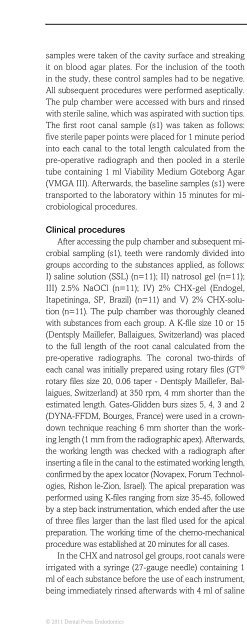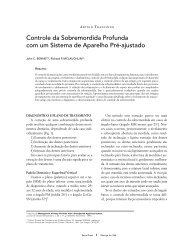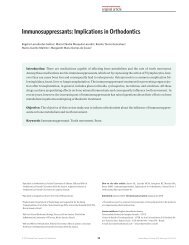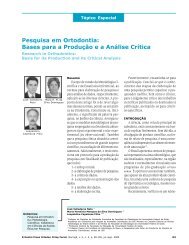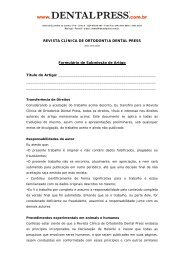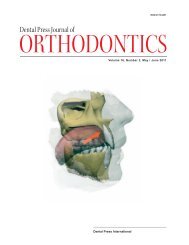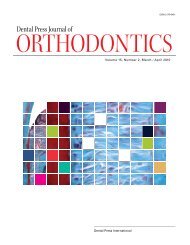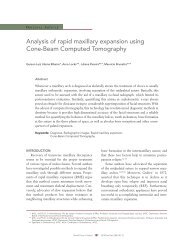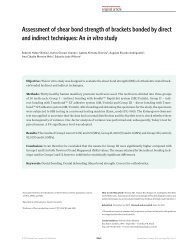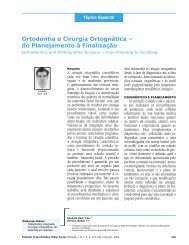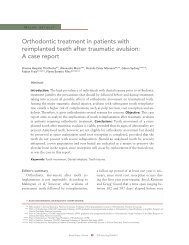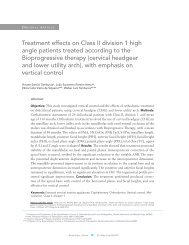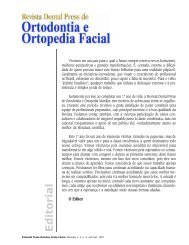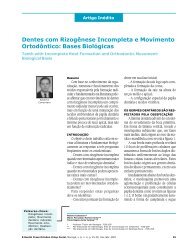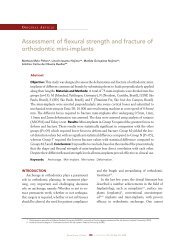Dental Press
Dental Press
Dental Press
Create successful ePaper yourself
Turn your PDF publications into a flip-book with our unique Google optimized e-Paper software.
[ original article ] The persistence of different calcium hydroxide paste medications in root canals: an SEM studyIntroductionThe elimination of microorganisms in the root canalenvironment prior to obturation is of paramountimportance for predictable treatment of apical periodontitis,and literature demonstrates the necessityof using an intracanal dressing to achieve such goal 1-5 .Calcium hydroxide (Ca[OH] 2) has been used successfullyin endodontics as a microbicide agent, dueto its ionic effect observed by chemical dissociationinto calcium and hydroxyl ions. The last inhibits bacterialenzymes by acting on the cytoplasmic membraneof the bacteria, generating irreversible effects,while calcium activates tissue enzymes such as alkalinephosphatase, leading to a mineralizing effect. 2,4The use of Ca(OH) 2, however, is not limited to itsmicrobicide action. Other uses of this substance includeinhibition of tooth resorption 4,6,7 and inductionof repair by hard tissue formation, 4,8,9 which makes itsuse recommended in many clinical situations. 4 Currently,this chemical is considered the best medicamentto induce hard tissue deposition and promotehealing of vital pulpal and periapical tissues. 5The vehicle used with Ca(OH) 2to create a pastegrant chemical characteristics that will influence itsclinical handling during application and rate of ionicdissociation and diffusion. Some authors believe thathydrosoluble vehicles have better biological behavior(antimicrobial qualities and induction of tissuerepair), due to a higher ionic dissociation, whereasothers advocate the use of viscous or oily vehicles,since the alkaline properties of such pastes will onlybe exhausted after a longer period. 5,10,11,12Prior to obturation of the root canal system,though, calcium hydroxide must be completely removedin order to avoid failure of the treatment. 13Literature shows that this is a difficult, if not impossible,task. Margelos et al 14 have shown that it is necessaryto combine sodium hypochlorite (NaOCl) andethilenediamine tetracetic acid (EDTA) as irrigantswith hand instrumentation to improve the removalefficiency of Ca(OH) 2from root canal, but its completeelimination may not be achieved. Lambrianidiset al 15 found that even after irrigation with NaOCland EDTA, as well as reinstrumentation with a #25file, a considerable amount of calcium hydroxide(25 to 45%) from intracanal dressings remained attachedto the canal walls. Attempts of removing suchmedication with nickel-titanium rotary instruments,sonic or ultrasonic irrigation or citric acid instead ofEDTA also proved unsuccessful, given that Ca(OH) 2still remained in the root canal. 16-19The persistence of Ca(OH) 2in the root canal priorto obturation may lead to failure of the endodontictreatment by creation of voids in the root canalthat will not be properly filled, thus affecting apicalseal. 13,15,20,21 Even small amounts of Ca(OH) 2remainingin the root canal may obliterate dentinal tubulesaffecting sealer adhesion 20,22,23 or cause adversechemical reactions with the sealer, which may lead toan unpredictable prognosis. 14,20Since the vehicle used during the preparation ofthe calcium hydroxide-based intracanal dressing mayinterfere with its removal capacity, the purpose ofthis study is to evaluate under the scanning electronmicroscope the persistence of residues in the rootcanal from calcium hydroxide medications preparedwith saline solution, glycerin, propylene glycol 400 orpolyethileneglycol 400.Material and MethodsThirty-six bovine incisors with closed root apexeshad their crowns removed and root canals instrumentedup to a #50 master apical file according tothe step-back technique. Irrigation was performed using1 ml of 2.5% sodium hypochlorite between files,with a final flush of 1 ml 15% EDTA for 1 minutefollowed by 10 ml of distilled water. Specimens wererandomly assigned to six experimental groups, accordingto intracanal medication to be used, as follows:GI= no medication (control); GII= Ca(OH) 2P.A.powder (Synth, Diadema, SP, Brazil); GIII= Ca(OH) 2mixed with saline solution; GIV= Ca(OH) 2mixedwith glycerin (Synth, Diadema, SP, Brazil); GV=Ca(OH) 2mixed with propylene glycol 400 (Synth, Diadema,SP, Brazil); GVI= Ca(OH) 2mixed with polyethyleneglycol 400 (Synth, Diadema, SP, Brazil). Apediatric amalgam carrier was used in GII to placethe Ca(OH) 2powder inside the root canal, followingcompaction using a #2 Paiva endodontic condenser.The other groups had the root canals filled withthe aid of a Lentulo spiral bur (Maillefer, Ballaigues,Switzerland). Radiographs of the roots were obtainedboth in buccal-lingual and proximal views to assurethat the medication was homogeneous and no voids© 2011 <strong>Dental</strong> <strong>Press</strong> Endodontics 78<strong>Dental</strong> <strong>Press</strong> Endod. 2011 apr-june;1(1):77-81


